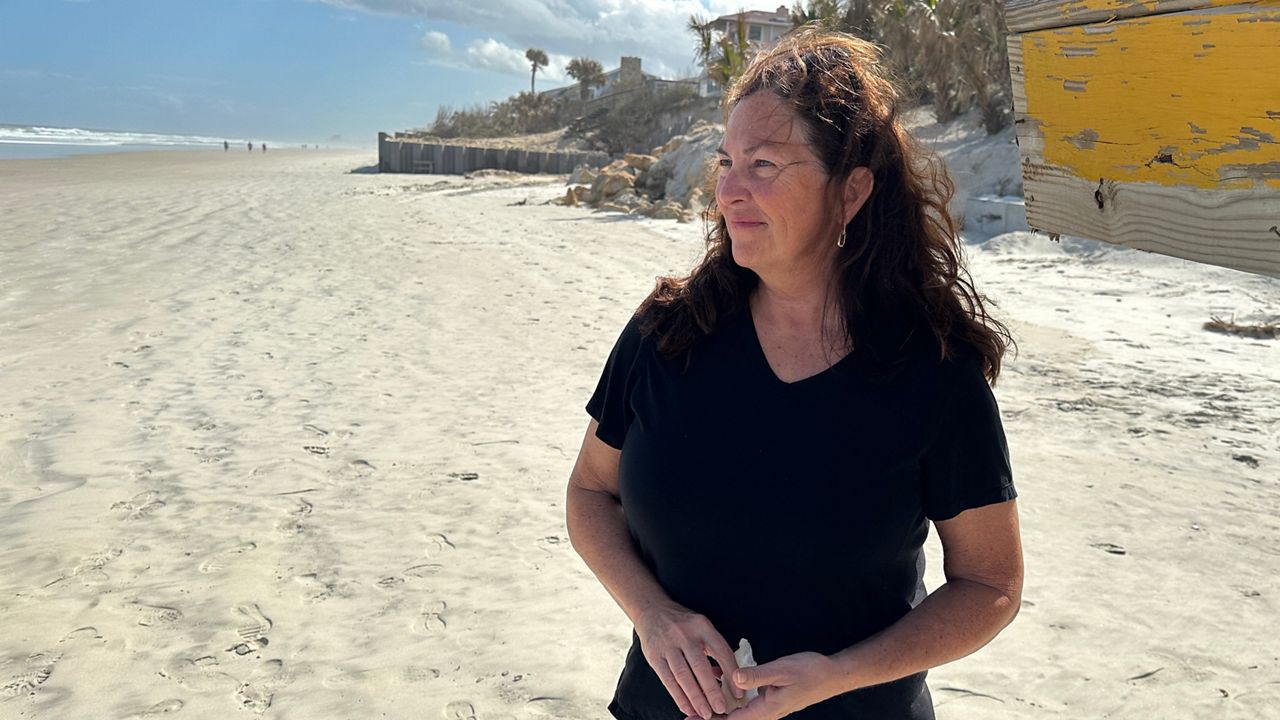WILBUR-BY-THE-SEA, Fla. — For many still searching for relief after Hurricane Nicole, Monday marks an important deadline: the last day to apply for FEMA funding.
Yet, that source remains one piece of a complicated — and long-term — recovery process for homeowners and Volusia County.
What You Need To Know
- The last day to apply for Hurricane Nicole physical damage relief funding is Monday, Feb. 13
- Many are still waiting on approved funds, while some have been outright rejected by FEMA multiple times
- Volusia County is also still working to restore seawalls and beaches ahead of this year's hurricane season
“When Nicole hit, it wiped everything out,” said Kelly Walker, a longtime educator who bought a coastal home in Wilbur-by-the-Sea five years ago.
Walker and her husband, Greg Knapp, moved from Virginia for a change of pace, hoping to snag a beachside home and turn their nest egg into a welcome vacation spot for their family back home. The couple just celebrated their first grandchild’s birth and Knapp hoped to retire.
But the back-to-back hurricanes devastated the coastal community in which the couple lives. Hurricane Nicole, in particular, sucked sand into the sea and left things splintered, rusted and exposed. Pounding waves and storm surge crumbled sea walls.
And though their home was for the most part spared, sans a deck and roof that will need to be replaced, their property, like neighbors on both sides, is in dire need of repairs, which the couple estimates will cost upwards of $300,000 to $400,000. They applied twice for FEMA aid and twice, they said, they were rejected.
Knapp said that to pay for the repairs, he’s contemplating continuing to work for several more years.

“We’re extremely vulnerable right now, very concerned. Not just for this month, but for September,” Walker said, referencing one of the busiest months in hurricane season. “(It’s) always a gut punch. You feel as though, ‘What’s the right answer? How do we get the money?’ … Nothing covers this and we’re stuck on how to pay for it.”
Further up the beach, it’s the same race against the clock for Volusia County.
Coastal Director Jessica Fentress, an engineer by trade, is at the helm of repairs to the more than 100 total beach access points.
Making the beach accessible for her own children was the chief reason Fentress took the job with the county.
Now, she is working to restore the same 37 miles of beach she and her family frequent on an almost daily basis in the summer, while in tandem trying to connect homeowners with resources they need to make their own repairs.
“We had $30 million of damage just to coastal assets. That’s not something you budget for,” she said.
After Hurricane Nicole, the majority of walkovers, coastal parks and vehicle access ramps were shut down. Now, Fentress said that significant progress has been made, as the county reopened all but three parks, almost half of the vehicle access ramps and many of the walkovers.
The county should have the seawall repaired by the end of the summer, she said, emphasizing that it’s imperative they avoid quick repairs and opt instead for a resilient design which anticipates future storms.
Volusia County has to go through a meticulous process to secure state and federal funds itself, documenting, laying out projects and courting bidders in a competitive way, abiding by the Florida Public Procurement Process.
In addition, Fentress is trying to shore up funding sources, like the $5 million from the state of Florida for emergency sand replacement; The county still needs easements from private property owners before they can place sand in front of their houses.
Fentress explained that she is working with the Florida Inland Navigation District to come to an agreement for sand located in a dredge material management area, known as Rattlesnake Island to the locals, among other sources.
Another $37.6 million, announced by Gov. Ron DeSantis in late January, will, too, need to be fleshed out.
But, Fentress acknowledged homeowners’ own difficulties and vastly different situations for repairs.
“A lot of private property owners are having trouble with insurance, funding, like SBA loans they may be qualifying for, but the check hasn’t come in yet,” she said. “If you have the financial means to take the necessary precautions, I urge you to do it as quickly as possible.”
Back at Walker’s home, the longtime educator still loves saddling up next to her large, bay windows, firing up her laptop to work remotely and staring out into the ocean. She said that she and her neighbors are frustrated, but found a sense of camaraderie as they collectively work to fix their homes.
“It’s our home, we want to make sure we have a home for our families to visit and for us to enjoy. It’s where we live,” she said. “We’re going to save it. We’ll do what it takes, with the help of our neighbors.”
According to Volusia County, the damage from Hurricanes Ian and Nicole is estimated to be $852 million.
For now, the DEP Portal remains open. Homeowners need to see if their coastal projects qualify.



